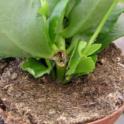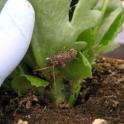Winter 2011 Field Observations
New “A” rated pest in San Diego: European pepper moth
by Jim Bethke
Duponchelia fovealis Zeller, a species of moth without a common name, was detected in a shipment of ornamental plants to Canada back in April of this year, and the trace-back led to a grower in San Diego County. Canada does not consider it to be an actionable pest since it has been found in the area in Canada where it was detected. The United States, however, considers it to be an actionable pest because it is known to be a serious agricultural pest, and it is not known to occur in the United States. This incidence in San Diego was a minor one, and following treatment applications, further surveys of the property could not detect any more moths or larvae.
Duponchelia fovealis damage to Kalanchoe stem. Other ornamental host genera include Anemone, Anthurium, Begonia, Cyclamen, Euphorbia, Gerbera, Kalanchoe, Limonium, and Rosa. (Click on thumbnail to view entire figure.) Photo by Jim Bethke
A second detection occurred in July, and again the trace-back lead to the same area of the county but a different grower. This detection triggered a survey to determine the extent of the invasion, and fortunately or unfortunately, the insect was detected in at least ten counties in California, but not in Imperial County where peppers and other host commodities are grown. Therefore, the invasion was taken seriously and the state entomologist wrote an emergency order. The incidence at the second grower’s facility was very extensive and caused a hold of all plants throughout the facility. It took approximately two weeks of intensive treatment applications in order to release portions of the crops for sale and distribution. Older plants were destroyed and younger plants were treated preventatively. In all likelihood, growers of European pepper moth hosts here in the county will have to treat preventatively to remain moth-free and be able to ship.
http://www.pestalert.org/oprDetail.cfm?oprID=466
Duponchelia fovealis moth pupa on the underside of a leaf. The pupa is attached to the leaf with webbing, and the larva uses nursery mix to make the cocoon. (Click on thumbnail to view entire figure.) Photo by Jim Bethke














